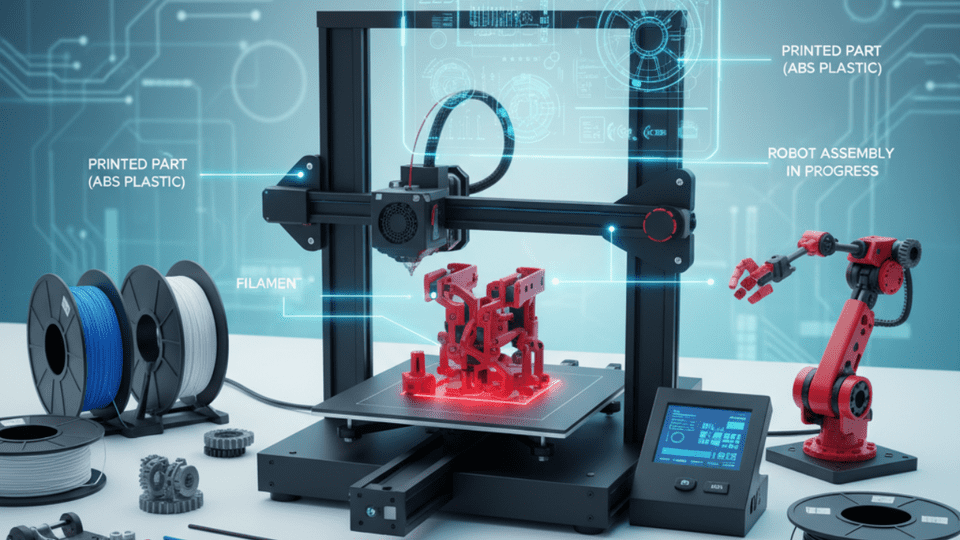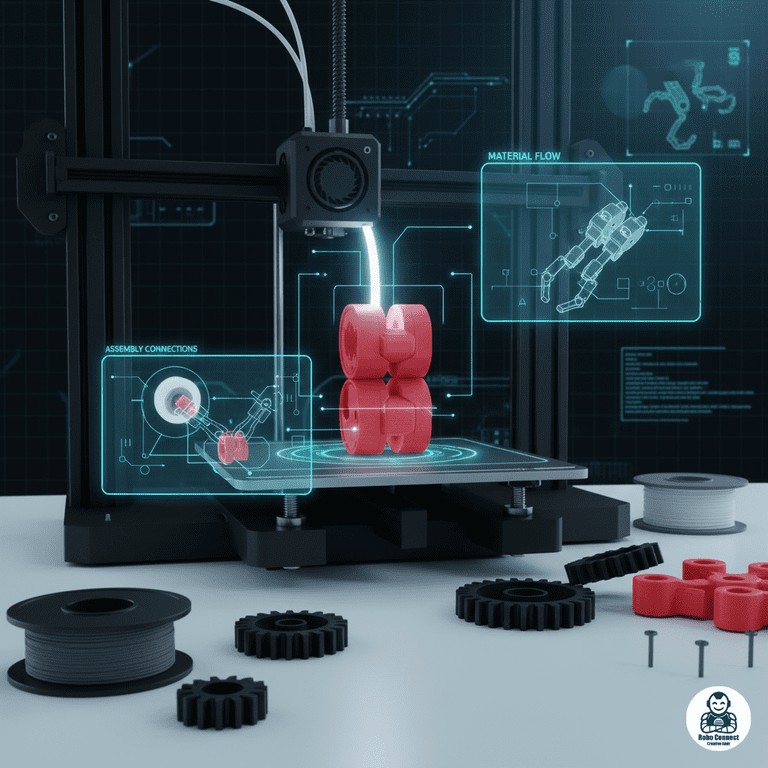Introduction
Imagine being able to design your own custom robot part — like a camera mount, sensor case, or even full robot chassis — and print it at home like printing a document.
That’s the magic of 3D printing .
In the maker world, 3D printing has become as essential as soldering or coding. It lets DIYers move from breadboards & prototypes → real, durable, professional‑looking hardware.
In this guide, we’ll explore:
- What 3D printing is and how it works.
- The main types of 3D printing for DIYers.
- How robotics enthusiasts use 3D printing.
- Beginner project ideas you can try today.
What is 3D Printing?
3D printing (additive manufacturing) is the process of creating 3D objects layer by layer from a digital model.
- You design a part in CAD software (Fusion 360, TinkerCAD, SolidWorks, FreeCAD, etc.).
- Software slices it into thin layers.
- The 3D printer builds the part layer by layer with filament or resin.
In short: You “print” objects you designed — not just flat documents.
Popular Types of 3D Printing for Makers
- FDM (Fused Deposition Modeling)
- Melts plastic filament (PLA, ABS, PETG) → builds layer by layer.
- Cheapest, most common for hobbyists.
- Example printers: Creality Ender 3, Prusa i3 MK3, Anycubic Kobra.
- SLA (Stereolithography / Resin Printing)
- Uses UV laser to cure resin.
- High detail, smooth finish, smaller parts → perfect for gears, intricate mechanisms.
- Example printers: Elegoo Mars, Anycubic Photon Mono.
- SLS (Selective Laser Sintering)
- Uses powdered nylon, fused by laser.
- Stronger, industrial grade → rarely used by beginners due to cost.
Why 3D Printing is Great for Robotics
- Custom Parts → Chassis, motor mounts, servo brackets, gear housings.
- Rapid Prototyping → Test designs quickly before CNC/manufacturing.
- Low Cost → Print parts at home instead of ordering special components.
- Creative Freedom → Design unique robots with custom shells, styles.
- Open Source Designs → Thousands of free files online (Thingiverse, PrusaPrinters, Printables).
Steps to Create Your First 3D Printed Robotics Part
- Design: Use simple CAD software (TinkerCAD for beginners, Fusion 360 for advanced).
- Slice: Import into slicer software (Cura, PrusaSlicer) → converts 3D file into layer instructions (G‑code).
- Print: Send to 3D printer with PLA filament → let it build.
- Test Fit: Mount motor, sensor, or PCB inside/custom part.
- Iterate: Re‑design or modify easily (perfect for DIY tinkering).
Pro tip: Start with PLA filament (easy, eco‑friendly, strong enough for robotics). Move to PETG or ABS for higher temp/mechanical strength.
Examples of Robotics Parts Made with 3D Printing
- Wheels & Tires: Lightweight drone/robot wheels.
- Motor Brackets: Custom fit motor holders for robot chassis.
- Sensor Cases: IR sensor mounts, ultrasonic housings.
- Gears & Levers: Replace difficult‑to‑buy plastic gears.
- Robot Arms: Joint + servo modules.
- Full Robot Body: Print a line follower or obstacle‑avoidance bot chassis.
DIY Project Ideas with 3D Printing
- Line Follower Robot Chassis (custom cutouts for sensors).
- FPV Drone Frame (lightweight carbon‑fiber PLA or PETG filament).
- Camera Pan‑Tilt Mount (for Raspberry Pi camera).
- Mechanical Robot Arm (servo‑driven, modular parts).
- Custom Enclosures (Arduino/ESP boards in neat cases).
Tips for Beginners
- Use PLA for easy prints (1.75mm filament).
- Level your print bed properly — 90% of failed prints start here.
- Download free designs first before making your own.
- Keep designs simple (avoid overhangs, use supports for complex geometry).
FAQs
Q1: How much does 3D printing cost?
- Hobbyist printers: 150–150–400.
- PLA filament: $20 (1 kg spool = dozens of parts).
Q2: Can I print strong functional parts?
Yes → use PETG or ABS filaments for strength, or resin printers for precision.
Q3: Do I need CAD knowledge?
Not initially. You can download pre‑made models. Later, simple CAD skills unlock endless custom builds.
Conclusion
3D printing is a game‑changer for robotics makers:
- Lets you build custom robot parts, test ideas quickly, and make your projects look professional.
- Printers are now affordable, filaments are widely available, and tutorials abound online.
If you’re serious about DIY robotics, adding a 3D printer to your maker toolbox is one of the smartest investments you can make.

